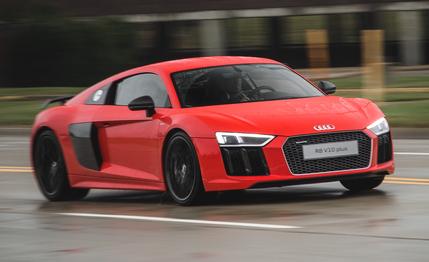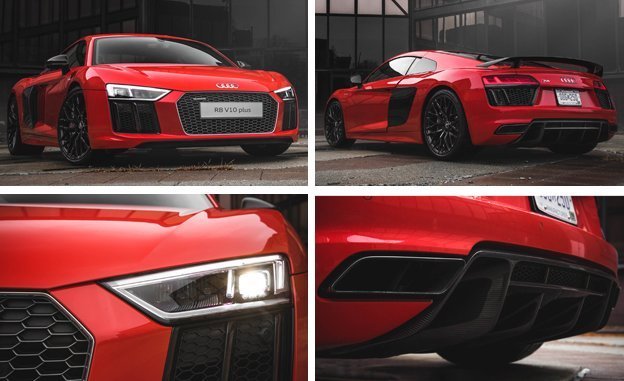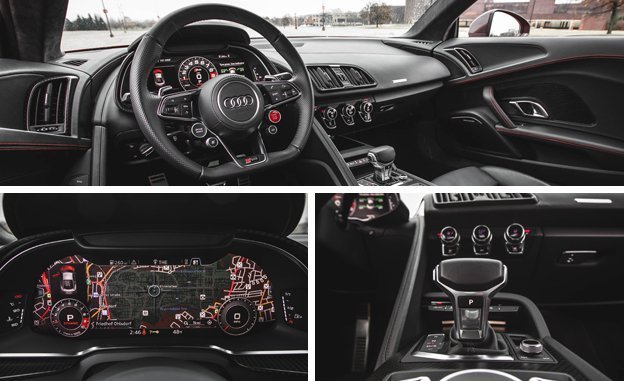 Instrumented Test
Instrumented Test
Audi delivered 27,000 copies (worldwide) of the first-generation R8—a massive amount by supercar standards but still a pittance in the grand scheme of things—so seeing one is an instant mood-lifter. Soon we’ll have the—again probably rare—opportunity to see the new, second-gen version, which arrives stateside this spring. Too eager to wait until then, we strapped our test equipment to this Euro-spec 2016 R8 V10 Plus, and the results ought to whet appetites for what’s to come.
The most notable difference between this Euro model and the U.S-spec car are the magnetorheological dampers, which we’d rate as beyond reproach after strafing our favorite 10Best Cars back roads. Sadly, these shocks will not be available here on the V10 Plus. Also, the stunning 20-inch wheels fitted to our test car will be painted a shade of silver—Audi calls it titanium—not gloss black. And our cars will be fitted with Homelink equipment but no fuel-scrimping stop-start system. Certain features that are standard in Europe—variable-effort steering and the exotic Bang & Olufsen sound system, for instance—will cost us extra. Finally, this car’s laser high-beam auxiliary headlamps are not legal in the U.S. and won’t be offered here.

The second-generation car is slightly longer, wider, and lower with a more aggressive face and rump mixed with less dramatic “sideblades.” A clutch pedal and a V-8 engine option are casualties, replaced by a 5.2-liter V-10 (in two strengths) backed up by a seven-speed dual-clutch automatic transmission with paddle shifting. Audi’s Quattro all-wheel-drive system received a full overhaul with a new computer-controlled clutch programmed to deliver the right amount of torque to the front axle, in place of the previous passive viscous inter-axle coupling. The front differential is open, as before, and the rear has a conventional limited-slip.
While the DOHC V-10 is not a totally new design, it’s invigorated with a higher compression ratio (12.7:1, up from 12.5), a more-efficient induction arrangement, and an injection system that squirts fuel into the combustion chamber and/or into the fully machined intake ports. There’s variable intake and exhaust timing for excellent drivability with low emissions and dry-sump lubrication to support your most ambitious driving maneuvers. Audi is especially proud of the V-10’s throttle response, touting its ability to rev from idle to full load in a mere 0.66 second, 20-percent quicker than previously.
Actually, we’re more impressed by the disappearing act that erupts when launch control is activated and the accelerator and shift paddles are pushed into action. The Plus edition of the 5.2-liter V-10 packs a convincing 610-hp wallop with 413 lb-ft of torque on tap at an enthralling 6500 rpm. (The regular V-10 is rated at 540 horsepower and 398 lb-ft.) The Plus’s combination of more-than-sufficient power, all-wheel traction, and launch control yields a zero-to-60-mph leap in 2.7 seconds, with 132 mph available in the quarter-mile after a brief 10.6 seconds. The run to 170 mph takes only 21.1 seconds. For reference, a $1.7-million Bugatti Veyron is going just 20 mph faster after 21 seconds of acceleration.
Credit also is due to a curb weight lower by 25 pounds thanks to a new carbon-fiber-reinforced space frame, the R8’s claimed 0.36 drag coefficient, and a rear wing that augments rear-axle loading by 220 pounds. Boasting a claimed top end of 205 mph, this is the fastest Audi ever sold for road use.

Like every legitimate supercar, the R8 has a well-rounded performance portfolio. It corners at 1.01 g with mild understeer at the grip limit and stops from 70 mph in 151 feet with no hint of fade thanks to its massive carbon-ceramic brakes and a static weight bias of 42/58 percent front/rear. In fact, it swings the g-needle over the 1.00-average mark in 0–60 acceleration, 70–0 braking, and skidpad cornering. And then there’s the accurate steering feedback, unshakable stability at the hairy edges of adhesion, and confidence-inspiring control of wheel and body motion.
But the best part is the voice trained by audio engineers who know how to extract rousing entertainment from this 10-cylinder band. The unequal firing order resulting from the use of a 90-degree cylinder-bank angle gives the soundtrack an edgy timbre that differs markedly from placid V-8s and silky V-12s. Never too loud or obstreperous, this engine has a beguiling howl that commences at around 3500 rpm and holds resolutely to the 8700-rpm fuel cut. Combine that with the soft chortle that follows every abrupt lift of the throttle, and you have an engine that knows how to maintain a captivating dialogue.
The R8 can also claim illustrious roots. In the late 1930s, when Audi was but one of the four rings served by Porsche’s first Stuttgart design office, Dr. Ferdinand Porsche and son Ferry imagined a mid-engine two-seat coupe powered by a four-cam V-10. Their Type 114 concept didn’t advance beyond detail drawings, but a scale model with a low nose and a narrow cabin was tested in a wind tunnel with favorable results. Audi’s latest sports car is convincing proof that a brilliant idea can have a very long shelf life.